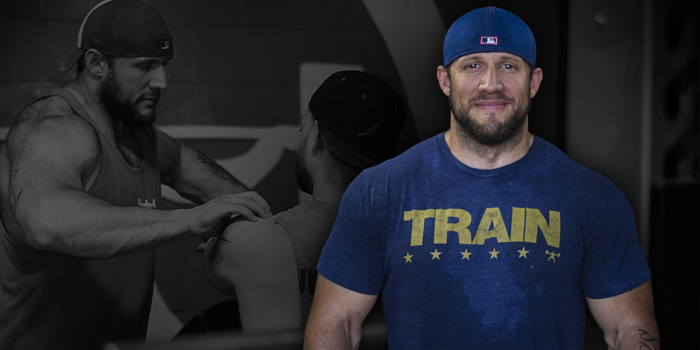
When it comes to pre-habilitation and rehabilitation, exercise selection is key. Selecting the correct exercise can be the difference between proper activation and creating tightness and fatigue. “Exercise economy” is a term not often used but important when trying to consolidate for precious time, energy, oxygen, and limit fatigue. Exercise economy (motion) is influenced by multiple factors, including neuromuscular co-coordination, percentage of type I muscle fibers (endurance), elastic energy storage (tendon), and joint stability and flexibility.
- Neuromuscular: The co-contraction of muscles and their individual muscle fibers is essential to economic contraction. The greater the co-coordination, the lower the energy demands placed upon the movement. The movement and motion will be more efficient, create better activation, and cause less fatigue.
- Fiber Type: Type I muscle fibers have a greater level of efficiency because of their ability to utilize oxygen better. It is easy to over-fatigue these muscle groups during pre-habilitation motions and movements. Less is more.
- Elastic Energy Storage (EES): Elastic energy storage and return has a positive effect on motion economy. The better the health of a tendon, the better economy of motion. Dynamic effort work and over-eccentrics are crucial to building tendon strength and health, further increasing exercise economy.
- Joint Stability and Flexibility: Joint stability and decreased flexibility both further enhance exercise motion economy. You read that correctly. Not being flexible is a good thing, to a point — advantage powerlifters and bodybuilders. Tissues that can recoil quickly due to inflexibility become better at using stored energy, and are able to reduce the involvement of unproductive muscles to stabilize joints. Joint centration also plays a crucial part in exercise and motion economy. The more centered a joint, the less work the surrounding muscles have to do to keep it there. Less work means more economy.
Now that we have established the boring stuff, let's go over three shoulder pre-training movements that you are probably doing that you shouldn’t be, then let's give you some better alternatives.
Standard Multi-Planar External and Internal Rotations
Transverse Plane
Every person at some point in his or her training career has done these. Whether it is out of boredom, lack of knowledge, or laziness, this shoulder warm-up is the old standby. It’s also shit. The concerning issue here is the over-involvement of gravity stabilizing the joint. Gravity works with the shoulder joint to create stabilization by depressing the humerus downwards toward the ground. You literally have to do nothing to stabilize the joint in this movement. Also, the shoulder joint works in a circumduction fashion in conjunction with the scapulothoracic complex; it does not act alone. In this exercise, you solely concentrate on just the ball and socket and not the entire complex. As we mentioned earlier, the co-contraction of multiple muscle groups creates a conservation effect on energy, creating a better bang for your buck. This exercise does not. Here is a better option:
Sagittal Plane
This is the same exercise as the one above but in a different plane of motion. Similar to the exercise above, gravity makes this exercise less optimal. As you rotate the dumbbell upward, gravity begins to act directly in line with the line of the movement. This creates an almost “wash” outcome, where the effort needed to stabilize the joint is almost nothing. The forces are acting against each other equally.
In the video above we demonstrate better alternatives for working the same movements in similar planes of motion. The key benefits are as follows:
- Dynamic motion across multiple planes of motion and joints
- Constant resistance of an opposite force, creating a greater need for stability
- Co-coordination of the scapulothroacic complex and the rotator cuff
- Variable resistance levels based on distance (great for graded exposure to strain)
- Meets the “exercise economy” principles listed above
Codman Exercise or “Pendulum Swings”
Developed by Edina Codman, this passive shoulder exercise does not involve a muscular contraction and is used almost as a way to increase passive range of motion. It is most often used as a post-surgical rehabilitation movement because of its ability to increase capsular movement and increase range of motion. However, I most commonly see individuals complete this exercise solely for the reason that it feels good. This use of this exercise is accompanied by holding a heavy weight and repeating the same movement. This creates a distraction within the joint and teaches the supporting muscles to contract. I see this as the only benefit to this exercise, but still there are better alternatives. The shoulder does not stabilize to its fullest through long, slow motions. Its ability to constantly receive feedback makes it a better fit for resisting short, quick movements. The exercise below is a better alternative.
This exercise involves the use of perturbations — small dynamic external motions that give immediate feedback the to working muscles and joints. The benefits of this exercise compared to our original above are as follows:
- Increased pre-activation stabilization and greater stability (perturbations in certain studies have been shown to do this)
- Increased cognitive function via increased anticipation of feedback
- Co-contraction of multiple shoulder muscles and joint complexes
- Active muscular contraction versus passive non-muscular contraction
Band Pull-Aparts
The band pull-apart has been a staple in pre-training rehabilitation and performance routines for decades. What it lacks in substance it makes up for in popularity. The focus here is activation of the scapular retractors, which are often lazy and weak. Defaults in this position include:
- Over-extension at the lumbar so one can decrease the range of motion needed
- Lack of subscapularis activation, which is needed for scapulothoracic stability and proper motion
- Missing co-coordination of pure shoulder (glenohumeral) and scapulothoracic (scapula, thoracic spine, and ribcage)
- Tension decreases where strength is biggest
- Establishing ribcage position for proper scapular rhythm
Listen, I’m not saying this is a bad exercise. I’m saying it is lacking a few key components that are necessary for a good pre-training routine exercise for the upper boost. Instead, try the exercise below.
This exercise, which shall remain nameless simply because I don’t have one, gives you the biggest bang for your buck when trying to implement a good economic upper body pre-training activation exercise. Combining isometric contractions, breathing, bracing, and rib cage position are just some of its main benefits. Others include:
- Co-coordination of the scapulothoracic and glenohumeral joint
- Ribcage stabilization
- Thoracic spine anti-extension and anti-flexion
- Multi-planar upper body activation
- Can be dynamic or static
All exercises have their time and place. What works for one lifter may not work for another. However, if you are performing these old exercises and still feel like a kid looking for a handout, here’s one: do the other exercises!











2 Comments